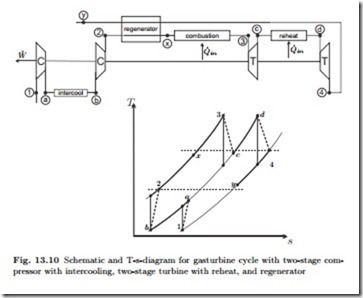Brayton Cycle with Intercooling and Reheat
Our discussion of compressors has shown that multi-stage compression with intercooling reduces the work required for compression. Applying this idea in a gas turbine cycle reduces the back work ratio, and also the temperature T2 behind the compressor. When a regenerator is used, the exhaust temperature Ty is limited by the temperature T2 after compression, which is lower with
multi-stage compression. Lower exhaust temperature Ty lowers the external irreversibility, and thus gives better efficiency.
In short, further efficiency gain can be obtained by using multi-stage compression with intercooling together with regeneration. Figure 13.10 shows schematic and T-s-diagram for a system with two-stage compression and re- generator that also includes two turbines stages with intermediate reheat.
Reheat increases the average temperature for heating, and thus the efficiency. The optimum reheat pressure can be determined by maximizing work, similar to the discussion is Sec. 13.3. If the turbines have the same inlet temperature, and the same isentropic efficiency, the maximum work is obtained when they have the same pressure ratio.
Since reheat increases the turbine exit temperature, reheat will increase the thermal efficiency only if accompanied by regeneration. The thermal efficiency of this cycle is obtained as
With intercooling and reheat, a larger portion of the heat can be exchanged in the regenerator, which reduces the exhaust temperature Ty and the corresponding exhaust loss, thus increasing the thermal efficiency. With more and more intercooling and reheat stages, the process becomes more similar to the Ericsson process.

